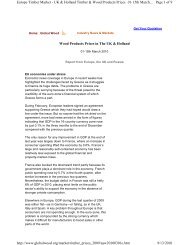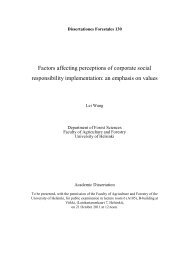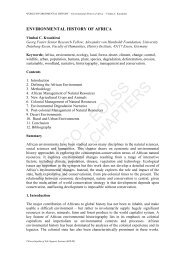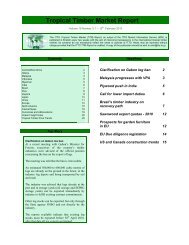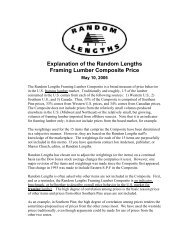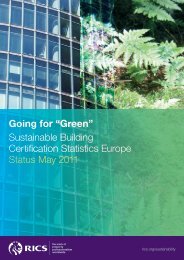ICT and e-Business in the Pulp, Paper and Paper ... - empirica
ICT and e-Business in the Pulp, Paper and Paper ... - empirica
ICT and e-Business in the Pulp, Paper and Paper ... - empirica
Create successful ePaper yourself
Turn your PDF publications into a flip-book with our unique Google optimized e-Paper software.
<strong>Pulp</strong>, paper <strong>and</strong> paper products<br />
4.2.6 Summary <strong>and</strong> conclusions<br />
The use of <strong>ICT</strong> is a key enabler of <strong>in</strong>creased process efficiency <strong>in</strong> <strong>the</strong> P&P <strong>in</strong>dustry,<br />
just as <strong>in</strong> o<strong>the</strong>r manufactur<strong>in</strong>g <strong>in</strong>dustries. Relevant applications <strong>in</strong> this context are ERP<br />
<strong>and</strong> SCM systems, o<strong>the</strong>r applications for manag<strong>in</strong>g capacity <strong>and</strong> <strong>in</strong>ventory, collaborative<br />
tools, e.g. for production plann<strong>in</strong>g (see Section 3.4). In particular, <strong>the</strong> <strong>in</strong>tegration of digital<br />
<strong>in</strong>formation flows dur<strong>in</strong>g all phases of B2B transactions (<strong>in</strong>clud<strong>in</strong>g order<strong>in</strong>g, <strong>in</strong>voic<strong>in</strong>g<br />
<strong>and</strong> payments) with production management <strong>and</strong> logistics has significantly facilitated<br />
bus<strong>in</strong>ess processes between P&P producers <strong>and</strong> <strong>the</strong>ir suppliers <strong>and</strong> customers (see, as<br />
examples, case studies "<strong>ICT</strong> for Production Track<strong>in</strong>g" <strong>and</strong> Nordic <strong>Paper</strong>).<br />
Effects are most pronounced if companies operate ERP systems <strong>and</strong> use <strong>the</strong>m as <strong>the</strong><br />
platform on which e-bus<strong>in</strong>ess processes are conducted. ERP systems are widely diffused<br />
<strong>in</strong> <strong>the</strong> P&P <strong>in</strong>dustry among larger companies, but not yet among smaller firms (see<br />
Sections 3.4.1 <strong>and</strong> 4.2.2). This translates <strong>in</strong>to a significant gap between large <strong>and</strong> small<br />
companies when it comes to more advanced forms of e-bus<strong>in</strong>ess.<br />
On <strong>the</strong> whole, <strong>the</strong> impact of <strong>ICT</strong> adoption with regard to process efficiency certa<strong>in</strong>ly <strong>in</strong>cludes<br />
<strong>the</strong> acceleration of processes (as illustrated by <strong>the</strong> VPK case study), an <strong>in</strong>creased<br />
company-<strong>in</strong>ternal transparency of processes (as illustrated by <strong>the</strong> Rexcell case study),<br />
<strong>and</strong> improved use of production capacity. Ultimately, <strong>the</strong>se effects certa<strong>in</strong>ly translate <strong>in</strong>to<br />
cost reductions for companies. However, this does not automatically imply an<br />
opportunity for competitive advantage of <strong>in</strong>dividual firms. Particularly among <strong>the</strong> large<br />
P&P firms, most companies are quite advanced <strong>in</strong> mak<strong>in</strong>g use of sophisticated <strong>ICT</strong><br />
systems for <strong>the</strong>ir B2B processes. The use of <strong>the</strong>se systems will <strong>the</strong>refore show <strong>in</strong> an<br />
<strong>in</strong>crease <strong>in</strong> productivity on <strong>the</strong> (aggregate) <strong>in</strong>dustry level. For smaller companies <strong>in</strong> this<br />
<strong>in</strong>dustry, process <strong>in</strong>novation by means of <strong>ICT</strong> can be a strategy to ga<strong>in</strong> competitive<br />
advantage.<br />
Acceleration of processes. In most of <strong>the</strong> larger P&P firms, <strong>the</strong> former manual<br />
h<strong>and</strong>l<strong>in</strong>g of orders <strong>and</strong> <strong>the</strong> related paper work has largely been automated by<br />
means of <strong>ICT</strong> (e.g. by ERP systems). This has enabled companies to accelerate<br />
processes <strong>and</strong>, thus, shorten lead times for <strong>the</strong>ir customers (i.e. reduce <strong>the</strong> amount<br />
of time between <strong>the</strong> plac<strong>in</strong>g of an order <strong>and</strong> <strong>the</strong> receipt of <strong>the</strong> goods ordered).<br />
Increased <strong>in</strong>ternal transparency of processes. <strong>ICT</strong> are a powerful tool to<br />
<strong>in</strong>crease <strong>the</strong> transparency of bus<strong>in</strong>ess processes with<strong>in</strong> a company. This is an<br />
important effect with implications for work organisation <strong>in</strong> this <strong>in</strong>dustry <strong>and</strong> should<br />
not be underestimated.<br />
Improved use of production capacity. <strong>ICT</strong> support P&P companies improv<strong>in</strong>g<br />
<strong>the</strong>ir plann<strong>in</strong>g processes <strong>in</strong> sourc<strong>in</strong>g, production <strong>and</strong> logistics, <strong>and</strong> enable wider<br />
collaborative processes such as vendor managed <strong>in</strong>ventory. This leads to an<br />
acceleration of order<strong>in</strong>g <strong>and</strong> delivery processes <strong>and</strong>, thus, to improved <strong>in</strong>ternal use<br />
of production capacity.<br />
134



